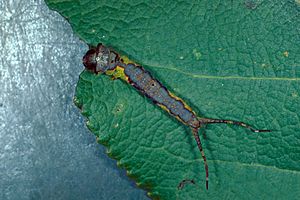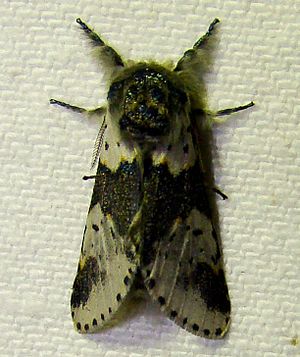White furcula moth facts for kids
Quick facts for kids White furcula moth |
|
|---|---|
 |
|
 |
|
| Scientific classification | |
| Kingdom: | |
| Phylum: | |
| Class: | |
| Order: | |
| Family: |
Notodontidae
|
| Genus: |
Furcula
|
| Species: |
F. borealis
|
| Binomial name | |
| Furcula borealis (Guérin-Méneville, 1832)
|
|
| Synonyms | |
|
|
The Furcula borealis, also known as the white furcula moth, is a type of moth. It belongs to the Notodontidae family, which are sometimes called "prominent moths" because of their unique shapes. You can find this moth in many parts of North America.
It lives in areas from New Hampshire all the way down to Texas and Florida. You can also spot it in states like Colorado and South Dakota.
Contents
About the White Furcula Moth
This moth is known for its pretty white and gray patterns. These colors help it blend in with tree bark, keeping it safe from predators. It's a medium-sized moth that flies mostly at night.
Size and Appearance
The white furcula moth has a wingspan that measures about 31 to 42 millimeters. That's roughly the length of a few paperclips lined up! Its wings are usually a mix of white, gray, and sometimes black markings. These patterns help it camouflage very well.
When They Fly
Adult white furcula moths are active for several months of the year. You can typically see them flying around from April through August. During this time, they are looking for mates and laying eggs.
Life Cycle and What They Eat
Like all moths, the white furcula moth goes through a complete metamorphosis. This means it changes from an egg to a larva (caterpillar), then to a pupa, and finally to an adult moth.
What Larvae Eat
The young moths, called larvae or caterpillars, have a special diet. They mostly munch on the leaves of certain trees. Their favorite foods include:
- Prunus avium (wild cherry trees)
- Salix species (willow trees)
- Populus species (poplar trees)
These plants provide all the energy and nutrients the caterpillars need to grow big and strong before they turn into pupae.
How Scientists Classify This Moth
Scientists use a system called taxonomy to group living things. This helps them understand how different species are related to each other.
Species Status
For a while, some scientists thought the white furcula moth might just be a type of Furcula bicuspis, which is another similar moth. However, after more study, it was decided that Furcula borealis is its own separate species. This means it's unique enough to have its own special name.

